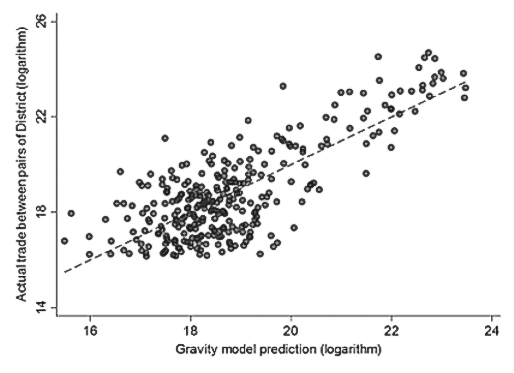In economics, a gravity model is a simple yet powerful tool that explains trade relations between countries. It’s based on the idea that trade lessens with distance but increases with the economic size of the trading partners.
We used an adapted version of this technique to study internal trade links between Rwandan districts in a research project for the International Growth Center. It proved useful in understanding the economic geography of Rwanda and identifying ‘missing’ trade links.
Our goals for the study were to build a model that predicts the proportion of trade between any two Rwandan districts and to identify underrepresented trade links—where the predicted level of trade is higher than the actual levels of trade.
Building a gravity model for internal Rwandan trade
A gravity model draws from the idea of gravitational pull: two objects attract each other more if they are nearby and have a large mass.
To build a gravity model of trade between districts in Rwanda, we made two key assumptions. We assumed that trade is proportional to the size of any pair of districts that are trading, estimated using their population. We also assumed that trade is proportional to the geographic distance between a pair of districts, measured in kilometers. These are reasonable assumptions to make, since the further away two districts are from each other, the more difficult and expensive it is for them to trade. The greater their populations are, the larger we would also expect their respective economies and trading opportunities to be.
Our model is a gross simplification of reality, but one that provides a strong signal.
Estimating actual trade between districts in Rwanda
We estimated the actual level of trade between all districts in Rwanda using a proxy derived from geotagged data of all Value Added Tax (VAT) transactions in Rwanda in 2017. Every business in Rwanda that is VAT-registered is required to use an electronic billing machine to capture all its transactions with customers. The electronic receipt that is generated has information on the value of each transaction and the location of the buyer and the seller, making it possible to estimate the total flow of formal trade in 2017 between firms across districts. This is an imperfect estimate since it excludes informal transactions which still dominate the Rwandan economy and other formal transactions that fall outside of the VAT system, but we can extract useful insights nevertheless.
We used the trade estimates derived from VAT data to parametrize the gravity model and make predictions on the level of expected trade, both imports and exports, between any pair of districts.
Learnings from comparing the gravity model to actual trade
We found that the model explains about 60% of the variation in internal trade in Rwanda. In figure 1, we can see a linear association between the predictions of the gravity model and the level of actual trade between pairs of districts.
Figure 1: Predictions of gravity model versus actual trade flows between pairs of Districts

Using this approach, we were able to identify ‘missing’ trade links between districts in Rwanda (see figure 2). Our predictions suggest that Kigali and Rusizi represent a much larger share of internal exports than we would expect, while districts such as Nyamasheke, Gatsibo, Nyatarare Kamonyi, Rubavu and Karongi are underrepresented in VAT data. Following gravity model predictions, we would expect the greatest growth potential for internal exports to be in the districts of Nyamasheke, Gatsibo and Nyagatare.
Figure 2: Difference between current and predicted proportion of domestic exports in Rwanda, by District

We need further analysis to understand what causes deviations from the gravity model, but one factor clearly stood out in our analysis. The internal road connectivity between districts is powerful in predicting their level of trade.
A footnote on building a gravity model: In a gravity model, the amount of trade between two countries is equal to a constant (called G), multiplied by the product of the GDP of both countries (each raised to a different power – say β1, β2), divided by the geographic distance between them (also raised to a different power level, say β3). The model is parameterized by these three powers and the constant, which can be estimated econometrically using a log-log regression model.
This blog post was written by Dimitri Stoelinga, Managing Partner at Laterite.
